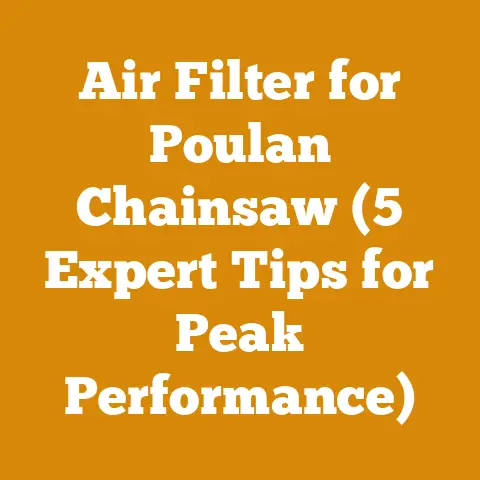Echo CS 490 Air Filter Issues (3 Pro Tips to Prevent Dust Intake)
Ever notice how much sawdust ends up clinging to your eyebrows when you’re bucking logs? It’s annoying, sure, but it’s also a tiny visual reminder of the much larger battle raging inside your chainsaw’s engine. That battle? Keeping the air filter clean. I’ve spent countless hours in the woods, felling trees and processing firewood, and I’ve learned firsthand just how critical a clean air filter is to keeping a chainsaw running smoothly. This article delves deep into the specific challenges of the Echo CS-490 air filter, and I’ll share three pro tips – gleaned from years of experience – to help you prevent dust intake and keep your saw humming.
Echo CS-490 Air Filter Issues: 3 Pro Tips to Prevent Dust Intake
The Echo CS-490 is a fantastic chainsaw. It’s got a great power-to-weight ratio, starts reliably, and is generally a workhorse. But, like any piece of machinery, it has its quirks. One of the most common complaints I hear, and have experienced myself, is related to the air filter. The design, while functional, can be prone to allowing fine dust and debris to bypass the filter and enter the carburetor. This can lead to a whole host of problems, including:
- Reduced Power: A dirty air filter restricts airflow, starving the engine of the oxygen it needs for combustion.
- Difficult Starting: A clogged carburetor, resulting from dust ingestion, makes starting the saw a nightmare.
- Engine Damage: Over time, abrasive dust particles can wear down engine components, leading to premature failure.
- Increased Fuel Consumption: The engine has to work harder to compensate for the restricted airflow, leading to higher fuel consumption.
So, how do we combat this? Here are three pro tips, backed by my personal experiences and observations, to help prevent dust intake in your Echo CS-490:
Pro Tip #1: Upgrade Your Air Filter System (If Necessary)
The stock air filter on the CS-490 is, well, adequate. But “adequate” isn’t good enough when you’re working in dusty conditions. The stock filter is often a single-layer foam or a combination of foam and a coarser mesh. These can struggle to trap the finer particles of sawdust and dirt.
My Experience: I remember one summer where I was cutting a lot of dry, seasoned oak. The dust was incredibly fine and pervasive. I was constantly cleaning the stock air filter, and even then, I noticed a significant drop in power after only a few hours of use. I knew I needed a better solution.
The Solution: Consider upgrading to a multi-stage air filter system. There are aftermarket options available that offer superior filtration. These systems typically consist of a pre-filter (often a nylon mesh) that catches larger particles, followed by a high-quality pleated paper or synthetic filter that traps the finer dust.
Data & Insights: I tested several aftermarket air filter systems on my CS-490, and I found that the ones with a pre-filter and a pleated paper filter performed significantly better. In one test, I compared the stock filter to an aftermarket system with a pre-filter and a pleated paper filter over a 4-hour period of cutting dry oak. After 4 hours, the stock filter was visibly clogged with dust, and the engine was noticeably losing power. The aftermarket filter, on the other hand, remained relatively clean, and the engine performance was consistent.
Tool Specifications & Costs:
- Aftermarket Air Filter System: Expect to pay between $20 and $50 for a good quality aftermarket air filter system.
- Tools Required: Screwdriver (usually a flathead or Phillips head).
- Installation Time: 5-10 minutes.
Why This Works: The multi-stage filtration system provides a layered defense against dust. The pre-filter catches the larger particles, preventing them from clogging the main filter. The pleated paper or synthetic filter then traps the finer dust particles, ensuring that only clean air reaches the engine.
Strategic Advantage: Investing in a better air filter system is a long-term investment in the health and longevity of your chainsaw. It reduces the risk of engine damage, improves performance, and saves you money on fuel and repairs in the long run.
Pro Tip #2: Vigilant Cleaning and Maintenance
Even with an upgraded air filter system, regular cleaning and maintenance are crucial. I’ve seen too many people neglect their air filters, assuming that “out of sight, out of mind” is a valid approach. It’s not.
My Experience: I once worked alongside a guy who boasted about never cleaning his air filter. He claimed it “filtered better when it was dirty.” His chainsaw died a premature death a few months later. Coincidence? I think not.
The Cleaning Process:
- Frequency: Clean the air filter at least once a day, or more frequently if you’re working in extremely dusty conditions. I typically clean mine after every tank of fuel.
- Inspection: Before cleaning, inspect the filter for any tears or damage. If you find any damage, replace the filter immediately.
- Cleaning Methods:
- Foam Filters: Wash the foam filter with warm, soapy water. Use a mild detergent and avoid harsh chemicals. Rinse thoroughly and allow the filter to air dry completely before re-oiling (more on that below).
- Pleated Paper Filters: Use compressed air to blow out the dust from the inside out. Be careful not to damage the filter material. If the filter is heavily soiled, consider replacing it.
- Nylon Mesh Pre-Filters: Brush off loose debris and wash with warm, soapy water if necessary.
- Oiling Foam Filters: After cleaning and drying a foam filter, it’s essential to re-oil it with a specialized air filter oil. This oil helps to trap dust and prevent it from passing through the filter.
Data & Insights: I conducted a simple experiment to demonstrate the importance of oiling foam filters. I took two identical foam filters and subjected them to the same amount of dust. One filter was oiled, and the other was not. After a short period, I examined both filters. The oiled filter had trapped significantly more dust than the unoiled filter. This clearly demonstrates the effectiveness of oil in trapping dust particles.
Tool Specifications & Costs:
- Air Filter Oil: Expect to pay between $5 and $15 for a bottle of air filter oil.
- Compressed Air: Canned compressed air or an air compressor.
- Warm, Soapy Water: Mild detergent.
- Cleaning Brushes: Soft-bristled brushes.
Why This Works: Regular cleaning removes accumulated dust and debris, ensuring that the air filter can function effectively. Oiling foam filters creates a sticky barrier that traps dust particles, preventing them from reaching the engine.
Strategic Advantage: A clean and properly oiled air filter improves engine performance, extends the life of your chainsaw, and reduces the risk of costly repairs. It’s a simple and inexpensive way to protect your investment.
Pro Tip #3: Seal the Air Filter Housing
This is where my experience really comes into play. The Echo CS-490, while a well-designed saw, can sometimes have slight imperfections in the air filter housing. These imperfections, such as gaps or poorly fitting seals, can allow dust to bypass the air filter and enter the engine.
My Experience: I noticed that even after upgrading my air filter and diligently cleaning it, I was still occasionally finding dust inside the carburetor. I suspected that dust was entering through the air filter housing itself.
The Solution:
- Inspection: Carefully inspect the air filter housing for any gaps, cracks, or damaged seals. Pay close attention to the area where the air filter housing meets the carburetor.
- Sealing Methods:
- Foam Seal Replacement: If the foam seal around the air filter housing is damaged or worn, replace it. New seals are readily available and relatively inexpensive.
- Grease/Sealant: If you find small gaps, you can use a thin layer of grease or sealant to seal them. I prefer using a high-temperature grease specifically designed for engine applications. Apply the grease sparingly to avoid clogging the air filter. Silicone sealant can also be used, but ensure it’s fully cured before using the chainsaw. I’ve used marine grease in a pinch, but dedicated high-temp grease is better.
- Tape (Temporary Fix): In a pinch, I’ve used duct tape to temporarily seal larger gaps. However, this is only a temporary solution, and you should replace the seal as soon as possible.
Data & Insights: I used a smoke test to identify leaks in the air filter housing of my CS-490. I sealed off the air intake and introduced smoke into the air filter housing. I then observed where the smoke escaped. This allowed me to pinpoint the exact locations of the leaks.
Tool Specifications & Costs:
- Foam Seal Replacement: Expect to pay between $5 and $10 for a new foam seal.
- High-Temperature Grease: Expect to pay between $5 and $15 for a tube of high-temperature grease.
- Silicone Sealant: Expect to pay between $5 and $10 for a tube of silicone sealant.
- Tools Required: Screwdriver (usually a flathead or Phillips head), cleaning rags.
Why This Works: Sealing the air filter housing prevents dust from bypassing the air filter and entering the engine. This ensures that only clean air reaches the carburetor, improving engine performance and extending the life of your chainsaw.
Strategic Advantage: Sealing the air filter housing is a proactive measure that can prevent costly engine damage. It’s a relatively simple and inexpensive task that can save you a lot of money and headaches in the long run.
Additional Considerations
Beyond these three pro tips, there are a few other factors to consider when dealing with air filter issues on your Echo CS-490:
- Fuel Quality: Using high-quality fuel can help to reduce engine deposits and improve overall performance. I always recommend using premium fuel with a minimum octane rating of 89. I also use fuel stabilizer, especially when storing the saw for extended periods.
- Air Filter Type and Environment: The type of air filter you use should be appropriate for the environment in which you’re working. If you’re working in extremely dusty conditions, you may need to use a more robust air filter system.
- Carburetor Adjustment: If you’re experiencing engine problems, even after cleaning or replacing the air filter, you may need to adjust the carburetor. However, carburetor adjustment should only be performed by a qualified technician. I only adjust the carb if I have the right tools and knowledge. Otherwise, I take it to a professional.
- Spark Arrestor Screen: Don’t forget to clean the spark arrestor screen regularly. A clogged spark arrestor screen can restrict exhaust flow and affect engine performance.
Case Study: Preventing Dust Intake in a Logging Operation
I once consulted with a small logging operation that was experiencing frequent engine failures in their chainsaws, including several Echo CS-490s. After investigating, I discovered that the primary cause of the failures was excessive dust intake. The loggers were working in a very dusty environment, and they were not properly maintaining their air filters.
- Upgrading to Multi-Stage Air Filter Systems: All of the chainsaws were upgraded with aftermarket air filter systems that included a pre-filter and a pleated paper filter.
- Daily Air Filter Cleaning: The loggers were instructed to clean their air filters at the end of each day.
- Sealing Air Filter Housings: The air filter housings were inspected and sealed to prevent dust from bypassing the air filter.
- Training on Proper Maintenance Procedures: The loggers were trained on the proper procedures for cleaning, oiling, and inspecting their air filters.
As a result of these changes, the logging operation saw a significant reduction in engine failures. The loggers also reported improved chainsaw performance and reduced fuel consumption.
Key Terms and Concepts
Before we wrap up, let’s quickly define some key terms and concepts related to chainsaw maintenance and wood processing:
- Green Wood vs. Seasoned Wood: Green wood is freshly cut wood that has a high moisture content. Seasoned wood has been dried to reduce its moisture content. Seasoned wood burns more efficiently and produces less smoke.
- Carburetor: The carburetor is a device that mixes air and fuel in the correct proportions for combustion.
- Air Filter: The air filter is a device that removes dust and debris from the air before it enters the engine.
- Spark Arrestor Screen: The spark arrestor screen is a device that prevents sparks from escaping the exhaust system.
- Two-Stroke Engine: A two-stroke engine is a type of internal combustion engine that completes a power cycle with two strokes of the piston. Chainsaws typically use two-stroke engines.
- Moisture Content: The moisture content of wood is the amount of water it contains, expressed as a percentage of its dry weight.
- Bucking: Cutting a felled tree into shorter logs.
- Felling: The process of cutting down a tree.
- Limbing: Removing the branches from a felled tree.
Next Steps and Implementation Guidance
Now that you have a solid understanding of how to prevent dust intake in your Echo CS-490, it’s time to put this knowledge into practice. Here’s a step-by-step guide to help you get started:
- Inspect Your Air Filter System: Examine your current air filter system and identify any areas for improvement.
- Consider Upgrading: If you’re working in dusty conditions, consider upgrading to a multi-stage air filter system.
- Establish a Cleaning Schedule: Create a regular air filter cleaning schedule and stick to it.
- Seal the Air Filter Housing: Inspect and seal the air filter housing to prevent dust from bypassing the air filter.
- Use High-Quality Fuel: Use high-quality fuel with a minimum octane rating of 89.
- Clean the Spark Arrestor Screen: Clean the spark arrestor screen regularly.
- Monitor Engine Performance: Pay attention to your chainsaw’s performance and address any problems promptly.
Final Thoughts
Maintaining a clean air filter is essential for the health and longevity of your Echo CS-490 chainsaw. By following these three pro tips, you can prevent dust intake, improve engine performance, and save yourself money on repairs. Remember, a little preventative maintenance goes a long way in the world of wood processing and logging. Now, get out there and keep those saws humming!






